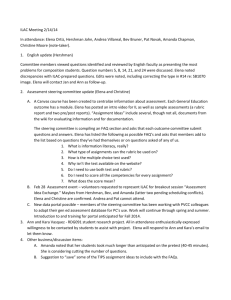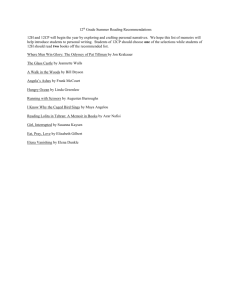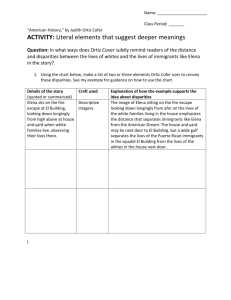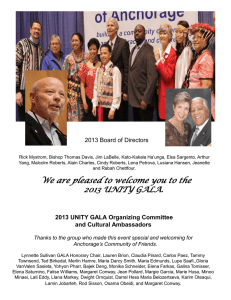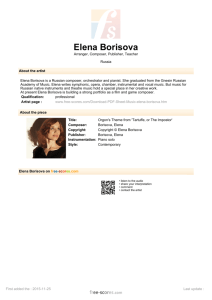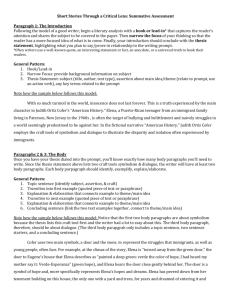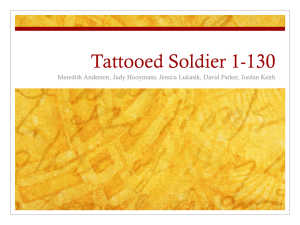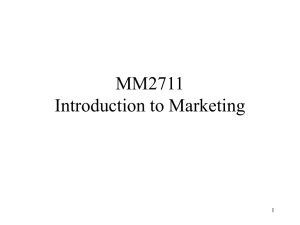change management
advertisement
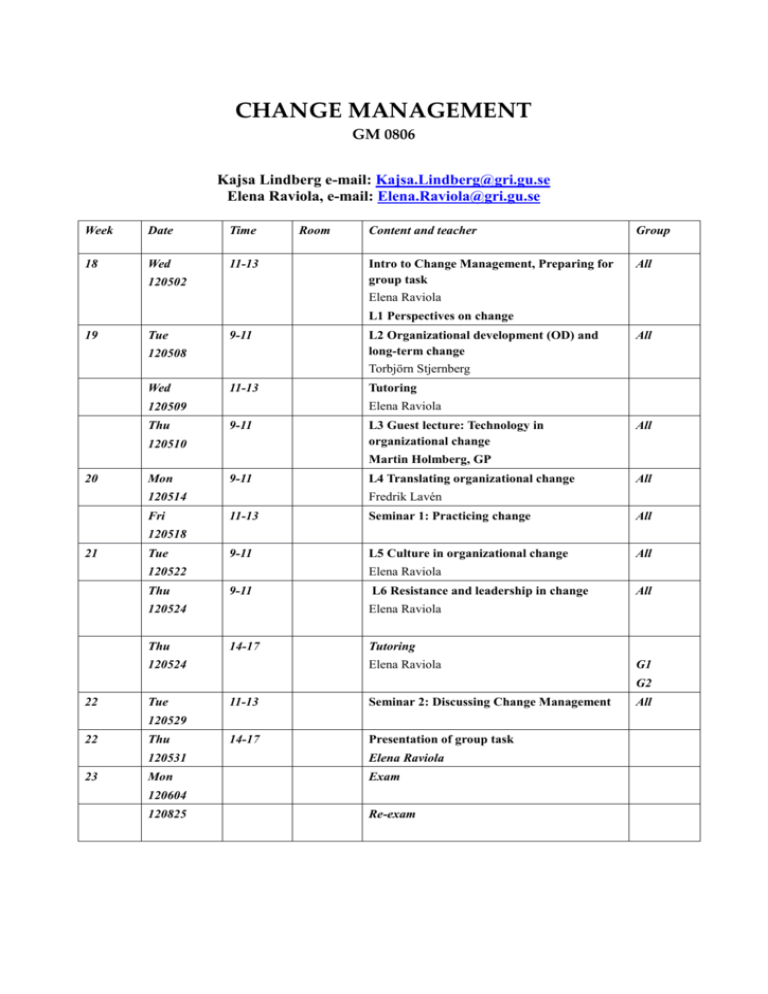
CHANGE MANAGEMENT GM 0806 Kajsa Lindberg e-mail: Kajsa.Lindberg@gri.gu.se Elena Raviola, e-mail: Elena.Raviola@gri.gu.se Week Date Time 18 Wed 11-13 120502 Room Content and teacher Group Intro to Change Management, Preparing for group task All Elena Raviola L1 Perspectives on change 19 Tue 9-11 120508 L2 Organizational development (OD) and long-term change All Torbjörn Stjernberg Wed 11-13 Thu Tutoring Elena Raviola 120509 9-11 120510 L3 Guest lecture: Technology in organizational change All Martin Holmberg, GP 20 Mon 9-11 All Fredrik Lavén 120514 Fri L4 Translating organizational change 11-13 Seminar 1: Practicing change All 9-11 L5 Culture in organizational change All 120518 21 Tue Elena Raviola 120522 Thu 9-11 All Elena Raviola 120524 Thu L6 Resistance and leadership in change 14-17 Tutoring Elena Raviola 120524 G1 G2 22 Tue 11-13 Seminar 2: Discussing Change Management 14-17 Presentation of group task 120529 22 23 Thu 120531 Elena Raviola Mon Exam 120604 120825 Re-exam All Lecture 1 Perspectives of change The aim of this lecture is to present a historical overview of different perspectives of change and change management, but also different “lenses” one can use in order to understand change processes. Thus, the complex and dynamic process of change are in focus. Literature: Dawson, Chapters 1-3 Lecture 2 Organizational development (OD) and long-term change Literature: Stjernberg, Torbjörn and Åke Philips (1993) Organizational Innovations in a long-term perspective: Legitimacy and souls-if-fire as critical factors of change and viability. Human Relations 46(10): 1193Shani, Rami and Torbjörn Stjernberg (1995) The integration of change in organizations: alternative learning and transformation mechanisms. Research in Organizational Change and Development, Vol. 8: 77-121. Lecture 3 Technology in organizational change In this lecture Martin Holmberg from the local newspaper Göteborgs Posten will present some of the organizational changes that the newspaper has undertaken as a consequence to the spread of digital technologies and changes in news consumption. Martin is leading the Digital Development Group at Göteborgs Posten, the fourth largest newspaper in Sweden. GP is a pioneer newspaper in Sweden, with regard to web and especially mobile services development. Thus, he will talk about the organizing of digital development at GP, focusing especially on the challenges of bringing change in an old organization and putting together journalists, marketers and technicians around digital development initiatives. Literature: Orlikowski, W. (1992) The duality of technology: Rethinking the Concept of Technology in Organizations. Organization Science, 3(3): 398-427. Lecture 4 Translating organizational change In this lecture we will discuss two perspectives on change and innovation that are prominent within studies of organization and management: the “diffusion model” and “translation model” (Latour, 1987). In the past, studies of change in general and innovation in particular have predominantly followed one particular framework: Their main focus lay with comparing the intentions of the actors participating in the change process with the achieved results. However, during the past decade the translation model has gained a lot of interest - it has become a fashionable concept - and many organizational scholars in Gothenburg are part of this movement. From such a perspective change, change management and innovation have been treated as ideas, which, when transformed into objects, circulate in and between organizations from one time/space to another (see e.g. Czarniawska & Sevón, 1996). The main point here is that ideas do not diffuse. Instead of the transmission of the same idea, which according to the diffusion model can merely be deflected or slowed down by friction, but remains essentially the same, the translation model proposes a continuous transformation of the idea. In doing so, the ideas contribute to the construction of many other things: new identities, new institutions, new products, new practices, new technologies or new structures. There is no master plan for innovation and no initial energy which moves a new technology or a new set of practices along a trajectory from Point A to Point B. There is no automatic diffusion, but there are plenty of uncontrollable translations. Literature: Bergström, O. (2007) Translating socially responsible workforce reduction – A longitudinal study of workforce reduction in a Swedish company. Scandinavian Journal of Management, 23: 384-405. Nicolini, D. (2009) Medical innovation as a process of translation: A case from the field of telemedicine. British Journal of Management. Lecture 5 Culture in organizational change The lecture focuses on organizational culture and its role in organizational change. It aims at discussing the complex interplaying between organizational culture and change management. We will discuss different perspectives on organizational culture, particular in relation to the political, symbolic and material dimensions of organizational change. Literature: Meyerson, D. and Martin, J. (1987) Cultural Change: An Integration of Three Different Views. Journal of Management Studies, Vol.24(6): 623-647. Hatch, M.J, (1993) The Dynamics of Organizational Culture. The Academy of Management Review, 18(4): 657693. Lecture 6 Resistance and leadership in change The lecture focuses on the complexities of organizational change implementation. It aims at exploring how change unfolds throughout organization, by looking at the same time at change and resistance to it and by presenting different theoretical perspectives focusing on resistance to change. The lecture will also deal with leadership in organizational change by discussing the multiple and varied role of leadership in organizing for change from different perspectives, in particular in connection to resistance. Literature Alvesson, M. (1992) Leadership as social integrative action. A study of a computer consulting company. Organization Studies, 13(2): 185-210. Battilana, J. (2006) Agency and institutions: The enabling role of individuals’ social position. Organization, 13(5) 653-676. Piderit, S.K. (2000) Rethinking resistance and recognizing ambivalence: A multidimensional view of attitudes toward an organizational change. Academy of Management Review, 25(4): 783-794 Seminar 1: Practicing change During the first seminar we will practice organizational change through a game. The instructions will be given in class. This game will serve as a base of discussion in class. Seminar 2: Discussing change management For the second seminar, the students will be required to watch an online lecture on an issue of change management (from a specific website whose address will be given to the students). Every student should reflect on the connections between the lecture (observed online) and other theories and issues discussed in the course. During the seminar students will discuss the main points of the lecture with other students. Grouptask: Learning outcome 2,3 and 4 includes identifying organizational problems, critically analyse and evaluate change processes in organizations. This will be done through a “case study”. The students will work in groups of three. Focus on one aspect/theme and seek for relevant literature in order to analyse the selected theme. The aspect/theme should be illustrated with a case. The case can be a “real” change project or a case presented in literature (e.g. a case study in a thesis or from a novel) or in media. The group work will be presented in the end of the course both by handing in a written report (amount for 40% of the final grading) and by an oral presentation. May 7, e-mail a draft (1/2 – 1 page) to Elena presenting an idea of what aspect your group will address May 21, e-mail a first version of the paper to Elena May 30, e-mail the final version of paper to Kajsa and Elena May 31, presentation of the paper App. 20 000 characters (with blanks), text size 12 pts, 1,5 space (app. 8 pages).

